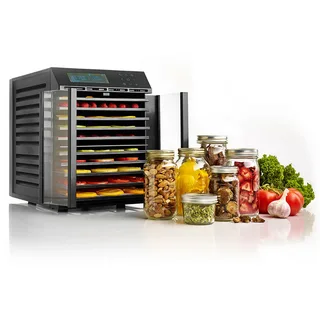
Dehydration is a popular method for preserving food and has been used for centuries. However, with the advancement of technology, a food dryer has become an essential tool for mastering the art of dehydration. This machine allows you to remove moisture from food while retaining its nutrients, flavour, and texture. Whether you are a professional chef or a home cook, a food-dryer can help you create delicious and healthy snacks, extend the shelf life of your produce, and reduce food waste.
Understanding the Basics of Food Dehydration
Food dehydration is an age-old preservation technique that involves extracting moisture from food items to inhibit the growth of microorganisms such as bacteria, yeast, and mould. This process effectively prolongs the shelf life of foods without the need for chemical preservatives or refrigeration.
By using a food-dryer, individuals can control the environment where the food is dried, including the temperature and airflow, which are critical for achieving the desired dehydration level without compromising the food’s nutritional content. The principle behind this method is simple: removing water creates an unsuitable environment for the microbial activities that typically cause food spoilage.
This makes dehydrated foods safe for long-term storage and preserves their flavours and nutrients in a concentrated form. Dehydrating food at home allows for a wide range of creative applications, from crafting nutritious snacks to preparing ingredients for future meals. It’s a straightforward yet versatile process that can be adapted for various types of food, including fruits, vegetables, meats, and herbs.
Preparing Your Food for the Dehydration Process
To ensure the success of your dehydration endeavours, initial preparation of your ingredients is paramount. Begin by washing fruits and vegetables thoroughly to remove any dirt or pesticides. Slicing your produce into thin, uniform pieces facilitates even drying and shortens the dehydration time. For certain vegetables, blanching is recommended as it halts enzyme activity, which could otherwise lead to spoilage; this step helps maintain both the vibrant colour and the original flavour of the produce.
When it comes to meats, thin, consistent slices are crucial, and marinating them beforehand can infuse additional flavours, enhancing the overall taste of the dehydrated product. Ensure that herbs are clean and moisture-free to preserve their aromatic properties. Paying close attention to these preparatory steps guarantees that the foods you dehydrate will last longer and retain a desirable texture and taste, setting the stage for successful dehydration projects.
Types of Food Dehydrators
When embarking on the journey of food dehydration, selecting the appropriate type of food dehydrator is crucial to match your culinary needs and kitchen space. Food dehydrators are predominantly classified into stackable tray dehydrators and shelf tray dehydrators. Each type presents its own set of advantages tailored to different dehydrating ventures.
Stackable tray dehydrators, known for their compact and space-saving design, are excellent for smaller kitchens or those embarking on dehydration projects on a more modest scale. These units allow for adding or removing trays to accommodate varying quantities of food, providing flexibility in batch sizes. Their vertical airflow system, whilst efficient for most tasks, may require occasional tray rotation to ensure even drying.
On the other hand, shelf tray dehydrators boast a larger capacity. They are favoured for their ability to handle substantial amounts of food simultaneously, making them ideal for extensive dehydrating projects or for preparing bulk quantities for storage. The horizontal airflow system in these dehydrators facilitates uniform drying across all trays without rotation, saving time and effort during dehydration.
Creative Ideas for Dehydrated Foods and Snacks
Unleash your culinary creativity by venturing into dehydrated delicacies and snacks. Transform ripe bananas and apples into crisp chips for a wholesome, crunchy treat. Venture into the savoury side by crafting zesty tomato and basil crackers from pureed ingredients spread thinly and dehydrated until crisp.
For those with a sweet tooth, consider dipping strawberries in dark chocolate before dehydrating them for a decadent yet healthier snack option. Jerky, made from lean beef or turkey marinated in your choice of spices, offers a protein-rich snack perfect for on-the-go energy. Alternatively, sprinkle a vibrant mix of dehydrated vegetables like carrots, peas, and sweet potatoes over salads or incorporate them into homemade trail mixes for a nutritional boost.
The art of dehydration extends the shelf life of your favourite foods and provides an avenue to craft innovative, flavour-packed snacks that cater to a variety of taste preferences. Explore the versatility of dehydrated foods to revolutionise your snacking habits with nourishing, homemade options.
Tips for Ensuring Optimal Dehydration Results
Achieving optimal dehydration results requires a nuanced understanding of your food-dryer and a mindful approach to the drying process. Always ensure that the pieces of food you intend to dehydrate are cut to a uniform thickness. This uniformity promotes even drying, preventing some pieces from being overly dry while others remain moist. Refrain from overloading your trays.
Overlapping or densely packed food can hinder airflow, leading to uneven drying and potentially fostering mould growth. It’s also crucial to adjust the temperature settings according to the type of food you are dehydrating. Fruits and vegetables typically require a lower temperature than meats to preserve natural sugars and prevent them from quickly hardening.
Regularly monitor the progress of your dehydration, especially towards the end of the drying cycle, to prevent over-drying, which can diminish flavour and nutritional value. Rotate trays if your food-dryer does not have an auto-rotating function, ensuring that all food items receive equal exposure to the heat source and airflow. By adhering to these guidelines, you can achieve consistently excellent dehydration results, enhancing the quality and longevity of your preserved foods.
Maintaining and Cleaning Your Dehydrator
Regular cleaning is indispensable to ensure your food dehydrator continues operating efficiently and safely. Begin by disconnecting the appliance from the power source to prevent electrical hazards. The trays, which come into direct contact with food, should be removed and washed using warm, soapy water. For any stubborn residue, a soft-bristled brush can gently scrub without damaging the trays.
It’s equally important to cleanse the interior surfaces of the dehydrator, including the door and any non-electrical parts, with a damp cloth to eliminate any leftover particles or drips. Attention should be given to the air vents and fan area, as accumulated dust or food particles could impair the machine’s functionality. Use a soft, dry brush or a compressed air duster to clear away any debris obstructing these components carefully.
Regular checks for wear and tear on electrical cords and examining the dehydrator’s components for any signs of damage are also advised, ensuring the unit remains in good working order. This meticulous approach to maintenance not only prolongs the lifespan of your dehydrator-machine but also guarantees that the quality of the dehydrated products remains consistently high, batch after batch.
The Health Benefits of Dehydrated Foods
Here are some health benefits of dehydrated foods:
Concentrated Nutrients
Dehydrated foods retain much nutritional value, as the dehydration removes water while preserving essential vitamins and minerals. Consequently, dehydrated foods often offer a concentrated source of nutrients compared to their fresh counterparts.
Extended Shelf Life
Dehydration effectively removes moisture, a critical factor in food spoilage. By reducing water content, dehydrated foods become less susceptible to microbial growth, extending their shelf life. This preservation method allows for long-term storage without refrigeration or chemical additives.
Portability and Convenience
Dehydrated foods are lightweight and compact, making them ideal for travel, hiking, camping, and emergency preparedness. Their reduced size and weight make them convenient for on-the-go snacking or adding to meals without adding significant bulk to a backpack or storage space.
Reduced Food Waste
Dehydrating excess or seasonal produce allows for its preservation, reducing food waste. Instead of letting fruits, vegetables, or herbs spoil, dehydrating them enables individuals to enjoy these foods later when they might not be readily available or affordable.
Versatility in Culinary Applications
Dehydrated foods offer versatility in culinary applications. They can be rehydrated and incorporated into various recipes, such as soups, stews, sauces, and baked goods. Additionally, dehydrated fruits make delicious snacks on their own or can be added to cereal, yogurt, or trail mix for added flavour and texture.
Incorporating Dehydrated Foods into Your Cooking
Integrating dehydrated foods into daily cooking routines can transform mundane meals into a culinary adventure. Utilise rehydrated vegetables by tossing them into a hearty stew or a vibrant stir-fry, infusing dishes with an intensified flavour that only dried produce can offer. Consider reviving dried fruits in warm water before adding them to porridge or yoghurt for a morning burst of natural sweetness.
FAQs
How does a food-dryer work?
A food-dryer operates by circulating heated air evenly throughout its compartments or trays. The airflow removes moisture from the food, gradually drying it out. Many food-dryers also feature adjustable temperature settings to accommodate different types of foods.
What foods can be dried using a food dryer?
A food dryer can dry a wide variety of foods, including fruits, vegetables, herbs, meats, and even some dairy products. It’s beneficial for preserving seasonal produce or making homemade snacks like dried fruit or beef jerky.
Are there any benefits to using a food-dryer?
Yes, there are several benefits to using a food-dryer. It helps extend the shelf life of perishable foods, reduces food waste, and creates convenient, portable snacks. Additionally, drying foods at home allows you to control the ingredients and avoid added sugars or preservatives often found in store-bought dried goods.
How long does it take to dry food using a food-dryer?
The drying time varies depending on the type of food, its moisture content, and the specific model of the food-dryer. Generally, thoroughly drying most foods overnight can take a few hours. Thicker or denser foods may take longer to dry than thinner slices or pieces.
Are there any safety considerations when using a food-dryer?
Following the manufacturer’s instructions and guidelines when using a food-dryer is essential to ensure safe operation. Proper ventilation is necessary to prevent overheating, and foods should be dried at the recommended temperatures to avoid potential food safety risks. Additionally, always ensure that foods are adequately cleaned and prepared before drying to minimize the risk of contamination.
Conclusion
Embracing the art of dehydration with a food-dryer offers a transformative approach to food preservation, enhancing the nutritional value and the flavour profile of your ingredients. Whether experimenting with snacks or integrating dehydrated foods into your cooking, the process will invigorate your culinary adventures. You can unlock many possibilities with a suitable dehydrator-machine and creativity, from crafting delicious, healthy snacks to innovatively elevating your everyday meals. Let the journey of mastering food dehydration enrich your diet and introduce you to a sustainable, flavourful way of living.










